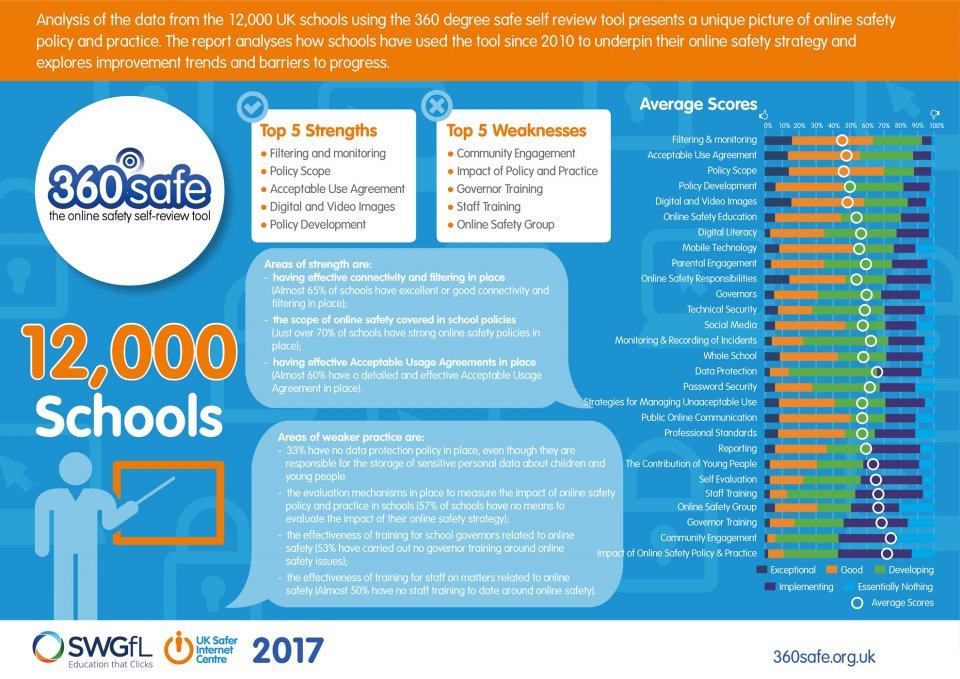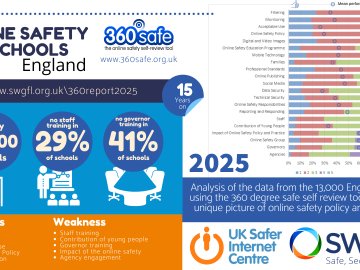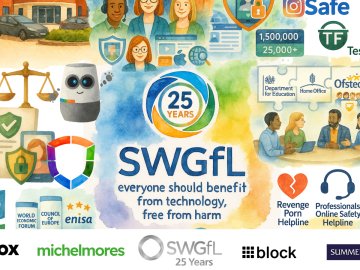Today (Tuesday 23 January 2018), SWGfL has published our annual 'State of the Nation' report into UK schools’ online safety policy and practice.
The report was compiled by Professor Andy Phippen from Plymouth University, and assesses data provided by more than 12,000 education settings using the multi award-winning ‘360 degree safe’ – an online tool that enables schools to review their online safety provision and develop an action plan to bring about improvements.
The tool continues to be adopted by a lot of schools – with more than 1,500 new registrations in the 2017. Of these 1,000 have embarked upon a self-review, showing online safety is still an important priority for schools.
Key findings
In general secondary schools perform better than primary schools, but the difference isn’t as clear as it once was, showing how primary schools have really engaged with online safety issues since we commenced analysis on the tool 7 years ago.

Aspects where secondaries do outperform primaries significantly - such as filtering, password security, mobile tech policy and technical security - are perhaps unsurprisingly those that we might view as more resource intensive.
However there are a number of aspects where primaries are ahead of secondaries, notably; policy development, policy scope, governor training, governor involvement, parental engagement, and policy around digital images and videos.
Filtering and Monitoring
Reassuringly, as per UKCISS guidance on schools to provide ‘appropriate levels of filtering and monitoring’ 97% of secondary schools and 90% of primary schools have at least basic levels of these in place, ensuring children can’t access inappropriate content at school and schools are checking what children are accessing.
Data
It is also positive to see improvements in data protection policy, although with impending new GDPR rules set to be implemented in May 2018 there is still significant room for improvement. Nonetheless with 70% of secondary schools having a policy around data protection, compared to 34% last year, showing an increased awareness of their responsibilities for keeping sensitive data about pupils and the wider school community safe in their care.
Online safety training
Over recent years, the report has disclosed a lack of knowledge amongst teachers and this definitely remains the case over the last 12 months, with around 45% having had no staff training to date around online safety.
The report also concludes that, despite significant improvement (up from 30% last year) in governor involvement over the past 12 months - with 55% of secondary schools and 50% of primary schools having no training in place for governors – this is an area with considerable room for improvement.
This raises concerns that without sufficient knowledge governors are unable to challenge senior leaders in schools about their online safety practices, which may place young people at risk.
In this 7th annual assessment report we can see that schools continue to make progress, in particular it reflects the progress primary schools are making from a time when online safety was viewed as very much a secondary school issue.
This is encouraging as we know that the earlier we start with online safety education, the greater potential we have for resilient, internet savvy children.
Despite there are some significant and worrying gaps.Training for staff is of particular concern as it is a fundamental requirement if online safety education and safeguarding are to be effective in a school. Similarly, given the important role governors play in challenging senior leadership this is an area where we would expect engagement levels to be higher.
Andy Phippen, Professor of Social Responsibility in IT at the University of Plymouth
Ken Corish, Online Safety Director at SWGfL went on to comment:
“It is encouraging to see that on the whole schools are continuing to make good progress in raising the standard of online safety provision, however with the recent publication of the government’s Internet Safety Strategy there is still room for improvement.
“In particular it is obviously worrying that schools continue to struggle with data protection compliance, and we would urge them to familiarize themselves with GDPR, and consider implementing our own self-review tool called 360data which helps organisations test and improve their data protection policies and practices.”
Key Statistics
- 97% of secondary schools and 90% of primary schools have at least basic levels of filtering and monitoring in place, ensuring children can’t access inappropriate content at school and schools are checking what children are accessing
- 70% of secondary schools have policy around data protection, showing their awareness of their responsibilities for keeping sensitive data about pupils and the wider school community safe in their care
- Almost 90% of secondary schools and 80% of primary schools have an online safety education programme in place in their settings, almost 50% of secondary schools have a detailed programme
- 86% of secondary schools and 80% of primary schools address digital literacy effectively in their curricula
- 70% of primary schools have policy around social media, an ever increasing issue for primary aged children
- 55% of primary schools and 47% of secondary schools have no strategy around how to engage the wider school community around online safety
- 55% of secondary schools and 50% of primary schools have no training in place for governors around online safety – concerning given governors provide challenge to the senior leadership on what they should be doing
- Around 45% of all schools have no strategy in place for staff training around online safety, a fundatmental requirement if online safety education and safeguarding are effective in the school.






